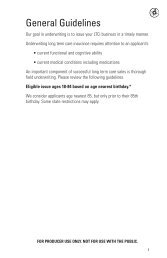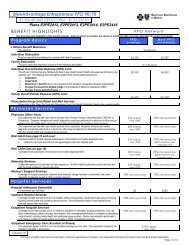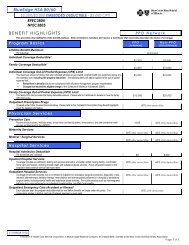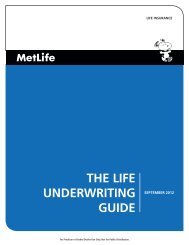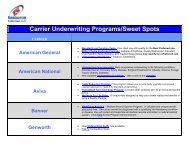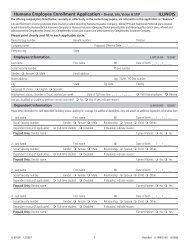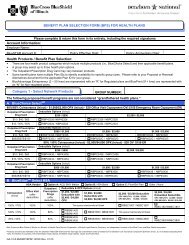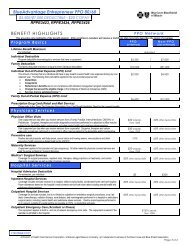THE LIFE UNDERWRITING GUIDE - Resource Brokerage
THE LIFE UNDERWRITING GUIDE - Resource Brokerage
THE LIFE UNDERWRITING GUIDE - Resource Brokerage
Create successful ePaper yourself
Turn your PDF publications into a flip-book with our unique Google optimized e-Paper software.
TEMPORARY INSURANCE<br />
WHEN IT’S AVAILABLE<br />
Temporary Insurance (TI) provides for a death benefit for the proposed insured should he or she die while the application is being<br />
underwritten. Also, if the health or insurability of the proposed insured changes once TI has started, the company will consider the<br />
health of the Proposed Insured as of the date TI began. The TI death benefit/freezing of insurability will be for the amount applied for,<br />
but never more than $1,000,000 ($2,000,000 for survivorship policies) under all TI receipts issued by MetLife companies.<br />
To be eligible for TI, the proposed insured must be at least 14 days old and never have received treatment or been diagnosed with any<br />
of the following: cancer, HIV, AIDS, coronary artery disease, stroke, or alcohol or drug use. In addition, the application (including any<br />
exams, amendments, and supplements) must not include any material misrepresentations.<br />
We offer three different versions of the Temporary Insurance Agreement (TIA). The traditional TIA (form number ETIA- 8-07)<br />
is part of the Client Package, is signed and dated only by the producer; and is left with the client. A separate TIA (form number<br />
ETIAET-57-08) is available for Tele-Application cases. It is part of the Tele-Application Forms Package and is signed by producer,<br />
insured and owner. One copy is left with the owner and one is submitted to Life Underwriting. These two TIAs are designed for use<br />
when the initial payment is collected at the time of application, EOT or ERF completion.<br />
A third TIA (form number ETIAPOST-52-07) is available when the initial payment is collected after the application or tele-application<br />
interview is completed. This form is not part of any package and is signed by the producer, insured and owner. One copy is left with the<br />
owner and one submitted to Life Underwriting.<br />
Note: This version of the TIA should not be used, and is invalid, if there has been any change in the proposed insured’s health since the<br />
date of the application.<br />
For TI coverage to be in effect, we must receive payment of at least one-twelfth of the annual premium amount or one of the following,<br />
if applicable: an Initial Premium Draft per Electronic Funds Transfer form, a Salary Deduction form, a Government Allotment form, or<br />
for ERISA qualified plans, an Employer Group Number on the application (a completed Commission Disclosure form must have been<br />
provided to the plan trustee).<br />
Assuming that one of the above has been satisfied, TI coverage will begin on the date of the application or the exam (if required),<br />
whichever is later. The exam need not have been completed for TI coverage to be in effect if death is the result of an accident and occurs<br />
within 30 days of the application. Generally, TI coverage will be in effect until either the policy applied for is in effect or is not accepted,<br />
until we decline the application or refund the premium, or 120 days from the date of the application.<br />
THREE WAYS TO APPLY<br />
MetLife now has three application processes to meet your client’s needs and schedule. Keep in mind that you should be proposing a<br />
product and amount of coverage based on your client’s financial needs, not solely to qualify for a specific underwriting process.<br />
TRADITIONAL <strong>UNDERWRITING</strong><br />
You complete the paper version of the Enterprise Application<br />
with your client, who is then considered using traditional underwriting<br />
requirements to offer the most competitive premium<br />
class available based on his or her insurability. The majority of<br />
this guide discusses the requirements and underwriting considerations<br />
used as part of the traditional underwriting process.<br />
Traditional underwriting with the paper Enterprise Application<br />
is available based on the following criteria:<br />
• Permanent plans<br />
– All ages, all face amounts<br />
• 30-year Guaranteed Level Term Plan<br />
– All ages, all face amounts<br />
• 10-, 15-, 20-year Guaranteed Level Term Plan<br />
– Ages 41 and over, for all face amounts<br />
– Ages 0-40, for face amounts $500,001 and above and<br />
under $100,000.<br />
– Ages 0-18, for all face amounts<br />
TRADITIONAL <strong>UNDERWRITING</strong><br />
WITH <strong>THE</strong> TELE-APPLICATION<br />
Focus your efforts on meeting your client’s insurance needs and<br />
let our Call Center focus on the field medical underwriting for<br />
you. Complete an Express Order Ticket and our Call Center will<br />
contact your client to complete the traditional Enterprise application<br />
using the eConsent signature.<br />
Since the Call Center will collect complete and specific details<br />
of your client’s health history, the traditional age and amount<br />
guidelines are modified to require a simple paramed in lieu of<br />
any full paramed exam noted on page 2. All other requirements<br />
and considerations in this guide would apply to Tele-<br />
Applications.<br />
Traditional underwriting through Tele-Application process<br />
is available based on the same criteria used by traditional<br />
underwriting as shown in the column at the left.<br />
20<br />
For Producer and Broker/Dealer Use Only. Not for Public Distribution.



